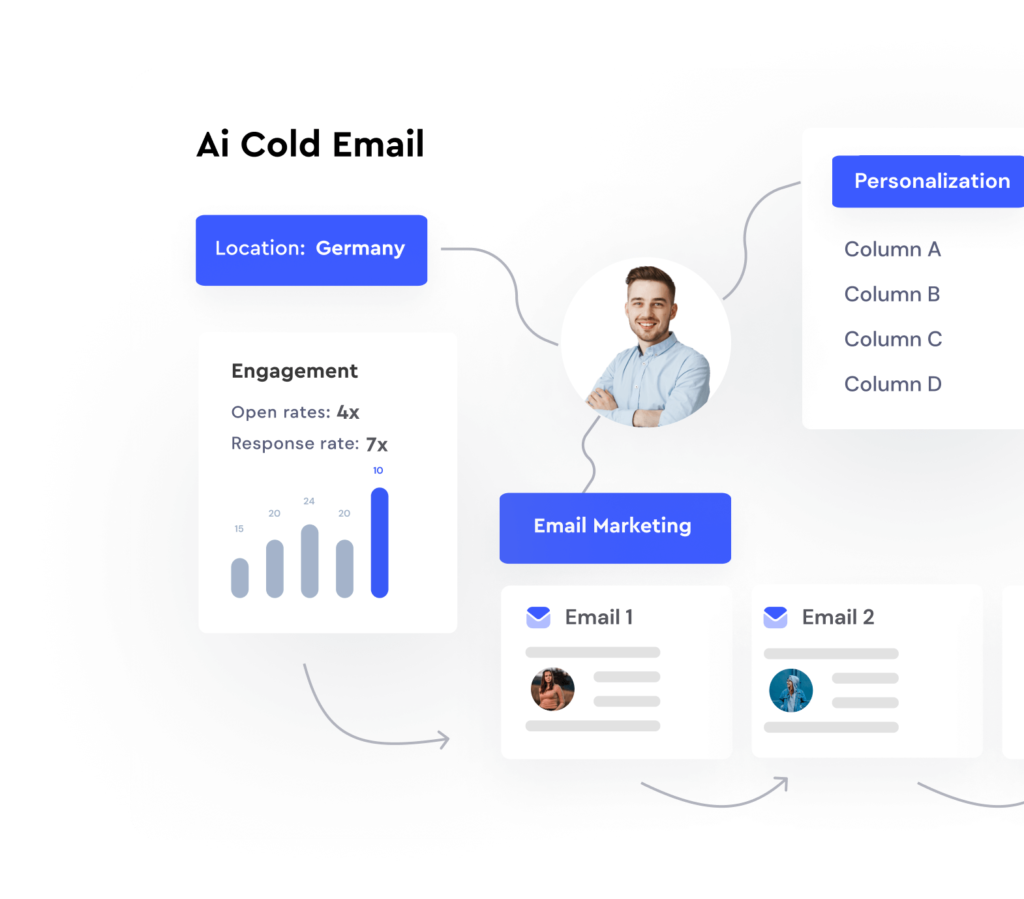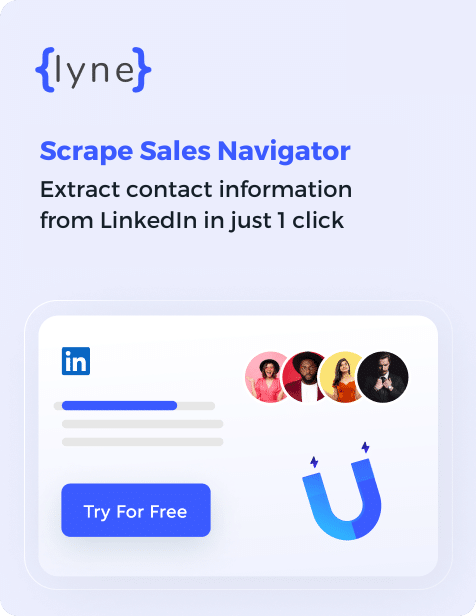Cold email outreach is a way to generate leads. It involves sending a personalized email message to a prospective client in hopes of building a relationship. It is considered “cold” outreach because these are people with whom you have had no contact with up until this point. In other words, these emails are unsolicited.
There are a few things preventing these emails from being considered spam. For starters, they are personalized, and spam is most definitely not. You are using the individual’s real name and demonstrating knowledge of who they are, what they do, and why they might be interested in your product or service.
Additionally, your objective is to simply begin a conversation with the client, whereas SPAM is designed to immediately and aggressively sell something.
Contents
8 Ways to Avoid the Spam Filter and Improve Email Open Rates
While cold email outreach can be used effectively, there are certain techniques and strategies that should be observed to increase your chances of making headway with a client. After all, less than a quarter of cold emails sent are actually opened, let alone responded to, so it’s far from a surefire way to get business. Here is a list of tips and tricks to help you get the most out of your cold outreach.
Keep Your Message Content Unique
While we all rely on spam filters to keep our email inboxes free from garbage that we do not want, if we are sending out cold emails, then we are the ones potentially being blocked by those filters.
Of course, we are not sending spam. Spam is junk mail, sent in large quantities, generally automated, and designed to pester potential customers into handing over their money. On the other hand, when you send a cold email, you are trying to strike up a genuine conversation in hopes of establishing a relationship with a potential client.
Unfortunately, the filters designed to spot junk mail do not always know the difference. There are a few things that can help your emails avoid the spam folder, but something you should always be doing is keeping the content of your message unique and personalized. A lot of companies send out mass emails that all use a similar template. This is a surefire way to get the attention of a spam filter.
Filters also watch out for key phrases, such as “order now” and “make money.” You definitely want to avoid using those phrases, and if you’re writing a sincere email, you’re likely not going to be using them anyway. The less your email sounds like a generic sales pitch, the less likely you are to use a word or phrase that the filter is looking for.
Think Past the Subject Line and Consider the Email Preview
Think about how your own email inbox is displayed. You are shown a list of emails and a preview of each message. Depending on your personal display settings, you could see the first couple dozen words of the email. This is the preview, so to speak, and it’s something to keep in mind when writing your cold emails.
The very first hurdle to landing that new client is getting them to open the email in the first place. However, before they do that, they can see the preview of your message. This is why the first few sentences that you write are so important. Even if they do not click on your email, they are still going to see those sentences.
This gives you an opportunity to reel them in and make them want to read more. Channel your inner salesperson and craft an opening that is either intriguing or compelling enough that the prospective client simply must read what you have to say.
Test Your Messages for Spam
There are tools out there designed to test and rate the “spammyness” of an email and these tools can be put to great use. By sending your message to a specified email, the tool will use a variety of criteria to assess your message and let you know the chances of it being flagged as spam.
A good tool is Mail-Tester, which will give your email a score of 1-10, with 10 being the best possible outcome. A score that high means that your email reads as unique and legitimate and should not have any issues making its way to a client’s inbox.
Do not Bombard the Client
When it comes to unwanted spam emails, the worst offenders are the ones who send several emails in a short time frame. This is another huge red flag for spam filters, because receiving several emails from the same address in a short period of time generally indicates that they’re being sent by an application and not a person.
There is no perfect answer when deciding how many emails to send out. If you ask different professionals, they are likely to give you different answers, but they will all agree that the emails should be infrequent and that, if you do not get a response, you should stop pestering the client after just a few emails.
Three emails in the space of a couple of weeks seems to be a good number for both avoiding the spam filter and gauging potential interest. If you have not received a response after the third email, it is probably safe to move on to another potential client. Continuing to send emails to the same recipient will not only annoy them, but you will also be wasting time you could be devoting to other clients who could very well purchase your product or service.
Lastly, if you send an irritating amount of emails to the same person, they’ll eventually manually flag your messages as spam, which doesn’t bode well for further messages sent from your email address, regardless of the recipient.
Set Your Profile Picture and Your Name
This is one of those things that may sound obvious, but people can underestimate just how powerful a profile picture can be. There is so much impersonal automation happening in today’s prominent industries that even the smallest human touch can have a substantial effect. Displaying your profile picture and your full name on your outgoing emails is one of those personal touches.
People are used to spam, which is cold and robotic, in large part because it is robotic. The process is automated. If they get an email that displays a legitimate name and a face to go with it, that could be the thing that prevents them from simply scrolling past your message and ignoring it. A friendly, professional headshot can speak volumes and communicate more than the text in the actual email.
Setting a profile picture is not just about first impressions, either. A lot of people online are understandably skeptical these days when it comes to dealing with people they’re not familiar with. Giving them your name and your face gives them the tools to look you up and make sure you are someone that they are comfortable doing business with.
And even if they do not bother researching who you are, you are still sending the message that you are comfortable with them doing so because you have nothing to hide.
Ditch Google and Switch to Outlook
For a long time, it was theorized that sending cold emails through Microsoft Outlook increased click-through rates. After paying attention to the statistics over the years, online professionals have come to the conclusion that emails sent through Outlook do indeed show more success than those sent through Gmail or GSuite.
Google’s email platform has proven popular over the years with its ease of use and its compatibility with other programs. Outlook, in comparison, is something of a clunky dinosaur that doesn’t always play well with others. This led to most professionals choosing Google’s service without considering whether or not their emails were actually being delivered.
At the end of the day, various tests have shown that sending emails through Outlook rather than Google results in a substantial increase in open rates. While nobody knows exactly why that is, the prevailing theory is that Outlook simply offers more reliable deliverability.
It does not matter how Google outperforms Outlook if the clients are not receiving your emails.
Design Your Subject Lines To Break the Pattern
This one employs a bit of psychology, so it may sound complicated, but it is pretty simple in practice. Using pattern breaking subject lines is all about breaking the recipient’s usual pattern of thought.
For example, if your prospective client gets over one hundred emails a day (which is not unusual for busy types), they likely don’t stop what they’re doing to consider each and every email that rolls in. They likely scan their inbox and, either intentionally or unintentionally, disregard any emails that look like spam, sales pitches, or something else they’re predisposed to ignore.
This is their pattern for dealing with unsolicited emails. You need to break this pattern. Your only real tool at this stage is your subject line, as they are going to see that before they even see the email preview. In fact, if they instinctively ignore that subject line, they will not even make it to the preview. So the subject line not only needs to be compelling, but it needs to break the pattern.
There are different schools of thought on how exactly to do this. If you Google the subject, you will find countless strategies that salespeople employ to break patterns. You could employ shock and awe, with a subject line that asks a very dramatic question. You can ask to steal a moment of their time, promising to never bother them again if you fail to impress them. The possibilities are endless.
Your mileage with each technique will definitely vary, but you don’t even have to use the techniques that you find. They could simply serve as inspiration for your own pattern breaking techniques.
Use an AI Tool like Lyne.ai
Yes, there are drawbacks to automating your cold email process. We have talked about automation a few times in this article and how it can lead to boring, boilerplate emails that clients ignore, assuming the emails make it past the spam filter in the first place.
That being said, automation isn’t a bad word, it’s simply something you need to be careful with. As your operation grows, you will need to rely on automation more and more as your workload expands. It is crucial that your personal touch doesn’t get lost as you scale and that’s where AI tools like Lyne.ai come in.
Lyne.ai is an artificial intelligence that can write personalized introductions for your cold emails. It can manage up to five hundred intros per hour, all staying on message while presenting that message in unique and colorful ways. If you get to a point where you are sending out hundreds of emails an hour, you are going to need help from a tool such as this.
Ironically, once you start sending out that many emails, using an AI program like this will probably result in less formulaic intros than if they were written by a person. If someone is writing all these introductions themselves, they are bound to repeat themselves a time or two.
Conclusion: Always Adapt
Sending out successful cold emails will always be difficult. As online business practices evolve, the landscape will continue to change, and techniques that previously worked wonders will become entirely ineffective. That is why it is always important to constantly be on the lookout for new strategies for reaching out to potential clients.
The core rules will remain the same, however. Personalize your messaging and do not be afraid to put your name and face out there. People want to know that they are dealing with real people. They want sincerity, which is very hard to deliver if you’re going the automated route. Once you consider the fact that you will need to use automation at some point, it becomes a very fine line to walk. The only way to keep your balance is with constant research into what is working and what is not.

Hi, I’m Achintam Karmakar, the SEO Guy at Lyne.ai. I work to improve Lyne’s online presence and bring you the best content.





